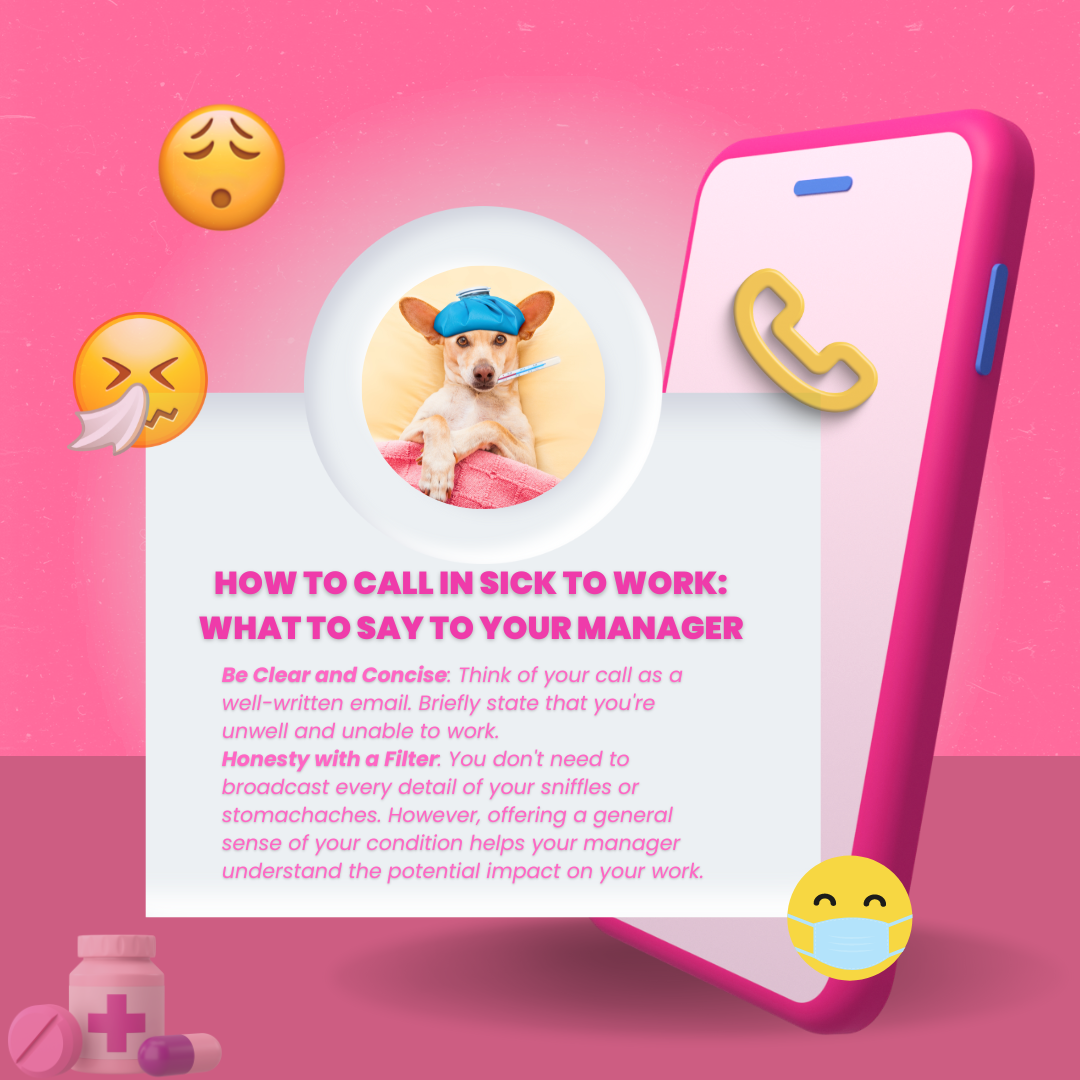The Ultimate Guide to the Most Effective Sick Leave Policy Strategies
From clear communication to flexible work options, learn the secrets to a stellar sick leave policy. Reduce costs, improve employee well-being, and optimize your workplace with these top strategies.

Calling in sick to work is common, but handling it professionally and considerately is essential.
A company may often have a specific sick leave policy for calling in sick to ensure that the workplace remains healthy and that employees can take the necessary time off to recover from illness without worrying about the impact on their jobs.
Understanding Your Company's Sick Leave Policy

While the exact details of these policies can vary widely from one organization to another, depending on factors such as the country's labor laws, the size of the company, the nature of its work, and its corporate culture, there are some common elements that many companies include in their sick leave policies.
Here are examples of components in a company's policy for calling in sick.
Notification Procedure
- Timing: Companies often require employees to notify their supervisor or HR department, usually before their shift begins, if they will be absent due to sickness.
- Method: This could be via phone, email, or a specific online system for reporting absences.
Documentation Requirements
- For short illnesses, a simple call or message may suffice. However, for extended absences, companies might require a doctor's note or medical certificate to validate the illness and the need for absence, especially if it exceeds a certain number of days.
Sick Leave Entitlement
- This outlines how many paid sick days employees are entitled to per year. Some companies may offer unlimited sick days, while others have a fixed amount. Unused sick days may or may not roll over to the next year, depending on the policy.
Payment
- Policies detail whether sick leave is paid or unpaid. In some regions, legislation mandates paid sick leave; in others, it's up to the employer's discretion.
Confidentiality
- Companies must handle medical information confidentially following privacy laws and regulations.
Return to Work
- There may be procedures for returning to work, especially after a lengthy illness, including a return-to-work interview or a gradual return plan.
Abuse of Sick Leave
- Policies also outline the consequences of abusing sick leave, such as disciplinary action for those falsely claiming sick leave or consistently taking sick leave without valid reasons.
Support for Sick Employees
- Beyond just outlining the dos and don'ts, some companies also offer support for employees when they are sick, which could include access to healthcare services, mental health support, or adjustments to their workload or responsibilities.

Examples from Specific Companies
While the above outlines common aspects of sick leave policies, companies may have unique approaches:
☂️ Google is known for its generous sick leave policies and employee health services, which aim to support physical and mental health.
☂️ Netflix offers unlimited time off for salaried workers, which includes sick days, emphasizing trust in employees to manage their own time off.
☂️ Walmart has specific policies detailing the accrual of paid sick leave, depending on the number of hours worked and location, reflecting the complex nature of managing a large and diverse workforce.
Employees should familiarize themselves with their company's specific sick leave policy. Understanding these policies ensures they can take time off without undue stress or confusion.
Managing Employee Sick Leave: Strategies to Minimize Disruption
For businesses, managing employee absences due to illness can present challenges such as reduced productivity, increased workload for other employees, and potential effects on morale.
Here are some formal and informal considerations for businesses:
Formal policies: Create clear policies on sick leave, including procedures for notifying supervisors, requirements for medical certificates, and the consequences of non-compliance.
Legal compliance: Adhere to local labor laws and regulations, which may include paid sick leave, medical privacy, and discrimination protections.
Communication: Ensure open communication channels for employees to report absences and for supervisors to respond appropriately.
The Impact of Post-Game Absenteeism on Workplaces
As the nation reeled from the excitement of the Super Bowl, a staggering phenomenon unfolded across workplaces. More than 16 million people were expected to miss work the day after the big game, many resorting to the all-too-common practice of feigning illness and making fake sick calls.
This mass absenteeism sheds light on the pervasive issue of deceptive sick leave and its impact on businesses while underscoring the need for a more transparent and supportive approach to employee well-being.
Staffing strategies: Plan for potential staff shortages by cross-training employees, hiring temporary workers, or offering overtime to cover essential tasks.
Employee wellness: Encourage a healthy work environment, offering resources for stress management, promoting work-life balance, and providing access to healthcare benefits.

Return-to-work interviews: Conduct informal meetings to discuss the employee's well-being, any adjustments needed for their workload, and potential concerns about their absence.
10 Tips for Calling in Sick Like a Pro
What to say to your manager when you must call in sick to work?

Here's a breakdown of how to inform your manager like a boss (while actually taking care of yourself like a boss too!).
Early Bird Gets the Rest
- Contact ASAP: The golden rule is to notify your supervisor before your shift starts or within your company's timeframe. This gives them time to adjust schedules and minimize disruption.
Be Clear and Concise
- State the Facts: Simply say you cannot work due to illness. There is no need to get graphic, but briefly mentioning the general symptoms (fever, chills, etc.) helps paint the picture.
The Return of the Pro
- Estimated Comeback: If possible, give your manager an idea of when you expect to be back. This helps them plan for your absence.
Know the Rules
- Company Policy 101: Brush up on your company's sick leave protocols. Who to contact? Is a doctor's note needed? Knowing this saves everyone time and confusion.
Self-Care as a Priority in Remote Work
- The Guideline for Remote Workers: Remote workers deserve sick days just like anyone else. In fact, taking a break when you're under the weather can be even more important for remote productivity.

Phone or Email? Pick Your Weapon
- Communication Channels: Follow company preference. A phone call shows concern, while an email provides a written record. Choose wisely.
Be a Team Player
- Considerate Colleague: Briefly acknowledge the inconvenience caused and offer to help manage your workload if possible. This small gesture shows responsibility.
Spreading Awareness (Not Illness)
- Inform Colleagues (if applicable): Let co-workers who rely on you know about your absence. This ensures smooth sailing while you're out.
Honesty is the Best Policy (Really)
- Skip the Fake Flu: Don't exaggerate or invent symptoms. Honesty builds trust and avoids future complications.
Rest Up, Champ!
- Recover, Don't Suffer: This isn't a race! Take the time you need to get genuinely well to avoid further setbacks.
The Grand Return
- Health Update: Once feeling better, give your manager a quick update and confirm your return date. They'll appreciate the heads-up.
Apologies Accepted
- A Touch of Courtesy: Express regret for any inconvenience caused. This shows respect for your colleagues and workflow.
Thank You, It Means a Lot
- Show Gratitude: Wrap it up by thanking your manager for their understanding. It fosters a positive work relationship.
Why it Matters: Imagine a domino effect. You come to work feeling under the weather, power through the day, and end up spreading your illness to half the team. Productivity plummets, deadlines get missed, and the chaos snowballs. Taking a sick day when needed isn't just about self-care; it's about preventing a domino disaster in the workplace.
Takeaways
- State the Situation Directly: Think of your call as a well-written email. Briefly state you're unwell and unable to work. Phrases like "I woke up feeling quite poorly" or "I'm not feeling well enough to concentrate today" are direct and professional.
- Honesty with a Filter: You don't need to broadcast every detail of your sniffles or stomachaches. But offering a general sense of your condition ("experiencing some flu-like symptoms") helps your manager understand the potential impact on your work.
Case Studies in Effective Sick Leave Communication
Scenario 1: The Surprise Illness
The Call
- Hi [Manager's Name], I'm calling to inform you that I woke up feeling terrible this morning with a fever. In the interest of everyone's health, I won't be able to come into the office today. I'll keep you updated on my condition and hopefully be back tomorrow.
The Email
- Subject: Calling in Sick - [Your Name]
Dear [Manager's Name], I am writing to inform you that I woke up this morning feeling unwell with a fever [and other brief symptoms, like chills or nausea]. To avoid spreading any germs, I won't be able to come into the office today.
I apologize for any inconvenience this may cause. I'll check my email periodically throughout the day in case of urgent matters and keep you updated on how I'm feeling.
I hope to return tomorrow, but I'll surely let you know. Thank you for your understanding. Sincerely, [Your Name]
Scenario 2: The Planned Doctor's Appointment
The Call
- Hi [Manager's Name], Just a heads-up that I have a pre-scheduled doctor's appointment for [time] on [date]. I've already finished [mention any urgent tasks] and can be reached by email if needed.
The Email
- Subject: Pre-Scheduled Doctor's Appointment - [Your Name]
Dear [Manager's Name], This email confirms that I have a pre-existing doctor's appointment on [date] from [time] to [time].
I've already completed [mention any urgent tasks you've finished] and will ensure everything is caught up before my appointment. I'll be reachable by email if anything critical comes up. Thank you for your understanding. Sincerely, [Your Name]
Scenario 3: Mental Health Day (Check company policy beforehand)
The Call
- Hi [Manager's Name], I'm reaching out to request a mental health day today. I'm feeling overwhelmed and believe taking a day to de-stress will allow me to return focused and productive. I'll be checking emails periodically for urgent matters.
The Email
- Subject: Mental Health Day Request - [Your Name]
Dear [Manager's Name], I am writing to request a mental health day today. Due to feeling overwhelmed lately, I believe taking a day to reset will allow me to return to work feeling more focused and productive.
I understand this may be short notice, and I apologize for any inconvenience it may cause. I will check my emails periodically for urgent matters, but otherwise, I'll be taking a break from work today. Thank you for your understanding and support. Sincerely, [Your Name]

Conclusion
You can ensure a smooth sick leave process by following these tips and tailoring your approach to specific situations.
Clear and considerate communication demonstrates professionalism and respect for colleagues and managers. After all, returning to work healthy and re-energized is the best outcome for everyone!
TMetric simplifies sick leave tracking by allowing employees to request time off and managers to approve it all within the same platform. This streamlines the process and ensures clear communication about absences.


